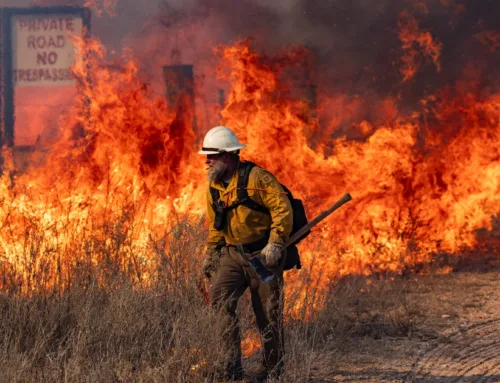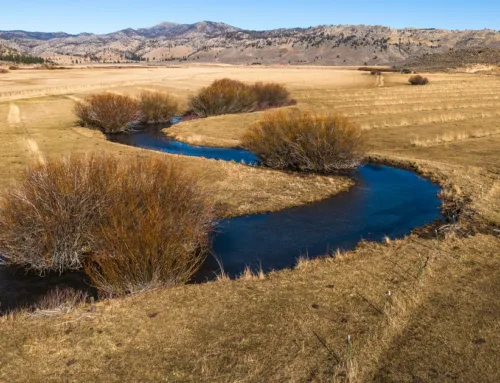Going Off the Grid: Chet Morrison
Going Off the Grid: Chet Morrison
Four miles from the nearest road. No electricity. No running water. Not even cell phone service. No matter.
“It took me more than a year to find this place,” Chet Morrison says as he gestures toward the larger-than-life views in every direction. “I’d say it was worth the wait, wouldn’t you?”
By Eric O’Keefe
No matter where you turn, stunning vistas encircle the property. Just a few feet from the back porch, the mile-high mesa’s rocky ridge drops down hundreds of feet into Chalk Draw, an enormous chasm that forms the watershed for tens of thousands of acres of surrounding ranchland. To the south, Elephant Mountain basks in the afternoon sun and the Rosillos Mountains loom in the distance at the edge of Big Bend National Park. Cathedral Mountain crowns the western horizon.
Given the setting, it’s hard to believe Morrison came across this stretch of high desert in the first place. Remote is an understatement. Think uncharted territory, terra incognita, Area 51.
“I found out about the Big Bend through my father,” Morrison says. “He was a poet, one of the pioneers of poetry therapy, as well as a teacher and a professor. A group of his friends had driven out to attend the Texas Cowboy Poetry Festival in Alpine [the nearest town]. They came back to Austin and told him how beautiful it was out here. Mild winters. Cool summers. Mountainous terrain. I always knew I wanted to see it for myself and kept talking about it, so my wife brought me here for my 50th birthday. We stayed at Cibolo Creek Ranch and made it our base for exploring the area. My very first trip and I knew I wanted to buy out here. I had the land bug,” he says.
Over the next 18 months, Morrison returned to the Big Bend on several occasions. He scouted in several properties, looked at listings large and small, and ended up making several offers. Although nothing came close to going under contract, he didn’t lose heart. Finally, his real estate agent brought up a long shot: the agent’s own deer lease.
The Double M sits four miles off the nearest paved road. “It was part of a 7,000-acre ranch that he had been hunting on for years. The rancher who owned the property had divided it up and was selling it as seven parcels. Normally, ranchers only sell to ranchers, so when he told me about it, I jumped on a Southwest flight, flew out from Dallas, and we had a look at all seven. When I saw this place, there was not a doubt in my mind. I told him I’d take it. When the rancher found out I wanted to buy the Draw Pasture, she said, “That one is the farthest from the road, the most out of the way, and the most difficult to get to.” And I said, “That’s exactly why I want it.”
In short order, Morrison became the proud proprietor of the Double M Ranch. The name honors the memory of his father, Morris Morrison. The rugged tract with an incredible expanse of views was full of possibilities, but it had no electricity, no running water, not even cell phone reception.
Morrison’s first consideration was water. “No water, no life,” he says. Good rains are a scarce commodity in West Texas. Annual rainfall in the northern reaches of the Chihuahuan Desert averages a little more than 12 inches, and lately there have been a few years when half that amount was registered. Rainwater catches or tanks were not a viable option on the Double M, so Morrison contacted Walter Skinner, a longtime local whose drilling and well service company enjoys a good reputation. Skinner says mountaintop wells can require drilling 500 feet deep, which at $13 a foot can quickly add up. That’s especially the case when you have to pay for a dry hole or two. Skinner got skunked twice before he hit pay dirt: 10 gallons a minute.
Water secured, Morrison turned to electricity. The site he chose for his homestead was 4.5 miles from the nearest power lines. According to figures provided by the local electric co-op, the base fee just to wire that span was $10 a foot, a staggering $237,600. And that’s not including any engineering fees or the cost of the dozens of phone poles required. Fortunately for Morrison, a friend recommended he get in touch with Meridian Energy Systems in Austin. Morrison not only contacted Andrew McCalla at Meridian but invited him out to his new property.
“In Texas, they don’t get a lot more remote than Chet’s,” McCalla says. “I saw the building site and said, ‘I understand why we’re talking.’ Electrical distribution is well established in Texas. That’s one of the reasons line extensions can get so expensive. At Chet’s, soil conditions and rugged terrain make it even more cost prohibitive. The good news is he had a ton of solar access, a large solar window.
“What we did first was build a load profile to figure out what his lifestyle would be electrically. In the case of this structure, how often it’s going to be used. It’s good to design a system that can accommodate for some variation. Most people just want the lights to come on and the beer to stay cold. We have to accommodate a variety of uses: Chet by himself for a weekend, Chet and Patty for a week, a three-month non-stop stay. And as system designers, we seek to lower costs and limit maintenance. It’s a vacation spot. Tinkering with your utilities is not how you want to spend your vacation.”
After meeting with McCalla and getting his bid, the decision was straightforward for Morrison. “My choices were either to pay $250,000 to the electric co-op and get an electricity bill every month or invest a fraction of that in my own solar system and never get another bill. I decided I was going to be the power company,” he says.
With the well in, it was time to build a house. Morrison initially turned to a well-known architect to build a home that blended in with the topography. “The design he came up with was absolutely fabulous. The only problem was when I forwarded the plans to contractors, none of them would return my calls. They were completely intimidated by the design and would say, ‘What it costs, it costs.’ That was a red flag. There’s every reason to believe that instead of building it for $100 to $200 a square foot, it would have ended up costing $1,000 a foot by the time they were finished with it.
Chet and Patty Morrison selected many of the furnishings in Dallas then trucked them out.
“So I paid for the plans, and then I went to see Richard Allen at Allen Realty in Alpine. He sells prefabricated homes that are built on site from Styrofoam, concrete, and steel. They’re a type of smart home, and they cost a fraction of what a custom home would have cost. If you can believe this, the two of us sat down and designed the house in 30 minutes. It wasn’t a cookie-cutter deal, either. I chose French doors, added windows, and rearranged the bedrooms. What I ended up with was a very nice 1,500-square-foot house with three bedrooms, two baths, a kitchen-dining room, and a living room. It’s a very tight house, incredibly energy efficient: Styrofoam covered with fiberglass batting, covered in concrete, totally tight.”
Morrison admits he was skeptical about the type of phone service he’d be getting out in the middle of nowhere. “When they told me that they were going to install a radio telephone, I envisioned myself going ‘Roger Wilco’ and clicking my handheld. Turns out it’s just like any other phone I’ve used,” he says. Thanks to the extensive fiber-optic network that crisscrosses the area, Morrison says the service he gets from the locally owned communications company is better than what he gets in Dallas. “For decades, remote ranches have relied on Big Bend Telephone Company. The company started out with two-way radios and later went to those party-line phones. Now they rely on the point-to-point microwave system that I use,” he says.
Morrison’s signal goes straight to a commercial antenna. Rusty Moore at Big Bend Telephone says they’ll soon be upgrading the Double M to satellite phones with high-speed Internet connections. “Here I am in the middle of nowhere, and I have the most sophisticated communications in the world outside my door,” Morrison says. Basic service? A whopping $18 a month. Total cost to install, including inverters and battery plant? $395.
One final note: Morrison’s hunch about ranchers selling only to ranchers proved correct. Of the seven parcels that initially came on the market, he bought the only individual tract. The other six were snapped up by a neighboring landowner, a man whose family has ranched in the Big Bend since the late 1800s.
“It turned out perfectly for me. Not only do I have just one neighbor to deal with, but he’s the best possible neighbor imaginable. I can’t tell you what a difference he has made,” Morrison says. “Things couldn’t have worked out better.”




